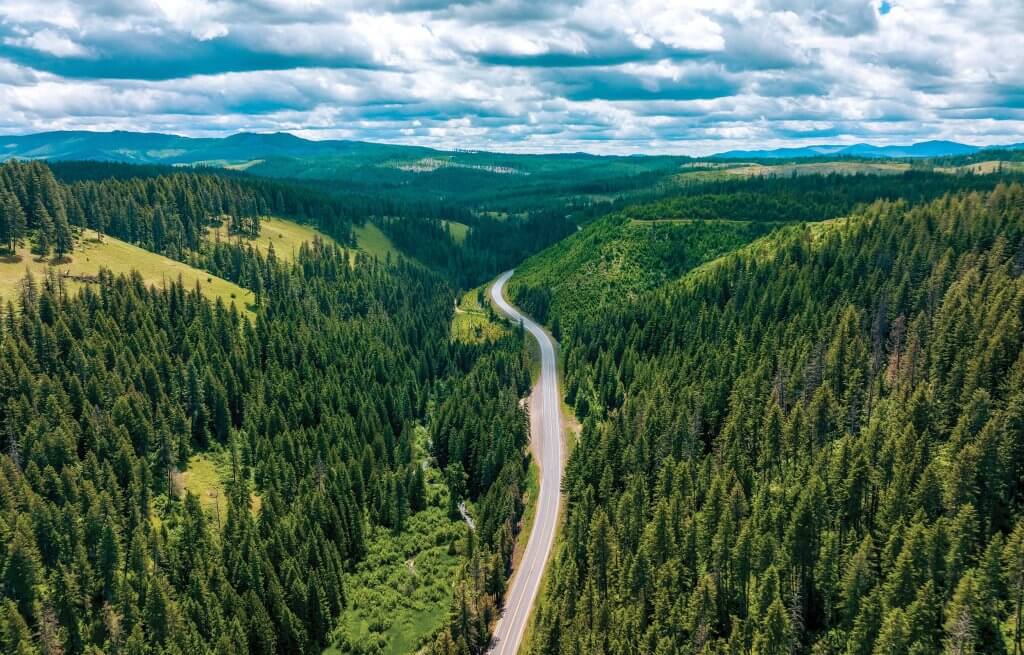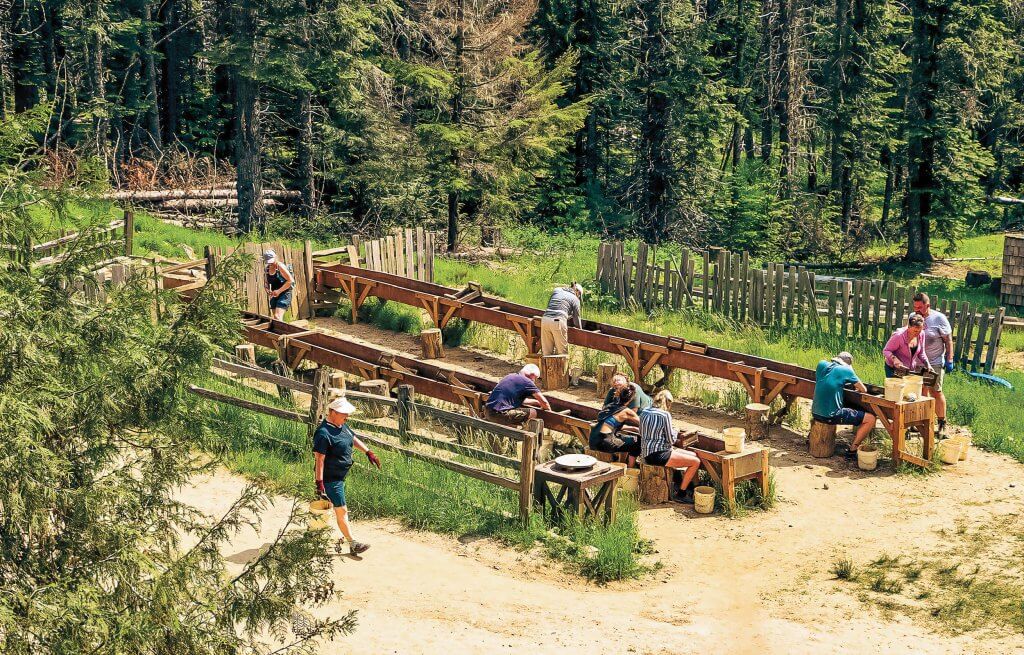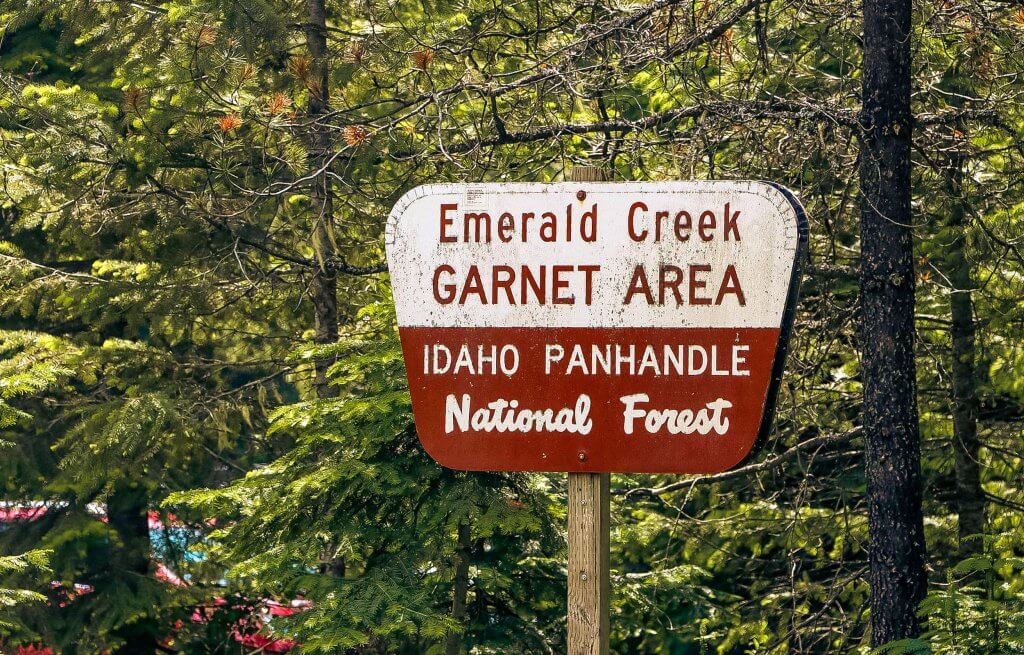Live A Wilder Life worked in partnership with Visit Idaho to create this Travel Tip.
Idaho is known as the Gem State, and with more than 240 types of minerals identified within its borders, the state definitely earns its moniker. Ranging from rare minerals to semiprecious gems, Idaho holds many notable treasures for rock lovers to uncover. But none of these gemstones are as rare as its state gem, the star garnet. Idaho and India are the only two places in the world where this semiprecious stone is found in significant quantity.
The star garnet gets its name from the four- or six-pointed star pattern that appears to flit upon the surface of the stone when properly cut and polished. The optical effect is called asterism and is created by rutile (a mineral consisting of titanium dioxide) needle formations inside the star garnet. This occurrence is unusual and found in very few gemstones.
Digging for star garnets is a popular summer activity for the whole family found in Idaho’s Panhandle. Located near St. Maries, Emerald Creek Garnet Area is a federal site that opens every year on Memorial Day weekend for organized mining. People from around the world come to this remote corner of Idaho to hopefully find their own ruby-red gem.
Paranoid that thousands of other passionate gem seekers would get the prized dig permits before us, I found myself waking up on a Saturday at 6:55 a.m. so I could hit the “buy now” button on the permit website the second the clock hit 7. I got a shot of adrenaline when my computer screen flashed a confirmation. As a family of self-proclaimed rock hounds, my husband and our five-year-old son had been impatiently waiting to get in on the action. With my son’s birthday falling a week after we’re set to visit the dig site, it was the ideal way to celebrate his sixth birthday. Most children have a natural pull to rock collecting, making this a great thing to do in Idaho with kids—but my son especially could spend all day every day looking for treasure. Whether digging through sand, collecting rocks on a hike or geocaching, he’s always had an eye for detail and finding the “diamond in the rough.”

Where to Find Star Garnets in Idaho
Heading south from Coeur d’Alene, we drove the White Pine Scenic Byway, a peaceful stretch of two-lane highway that takes you through some of northern Idaho’s most scenic waterfront communities. Passing by the bike-friendly Trail of the Coeur d’Alenes and the Coeur d’Alene River, we were tempted to stop and spend a few hours enjoying the early summer days together, but star garnets were calling our name.
Reaching the recreation area requires driving on a gravel road (Forest Service Road 447) for eight miles. The route is well-maintained, and any standard vehicle should be able to handle the terrain. When we pulled into the parking lot for our afternoon dig, prospectors from the morning session were returning to their cars. We struck up a conversation with an animated group of women who were boasting about who dug the most star garnets. Excited to share what was found, they pulled out their treasures and gave us our first look at the gemstones up close. As with many unpolished stones, these seemed unremarkable upon a quick glance—a misshapen black nugget. However, in the sunlight, you could see hints of maroon flush beneath the surface—the telltale sign of a star garnet.

The Experience
We walked the half-mile path to the sluice area, where a handful of other groups were already in line at the rangers’ desk. Your permit time slot allows you three hours, and showing up late doesn’t mean you are allowed to stay later. The rangers run a tight, albeit friendly, ship, and water used for the mining process is shut off promptly at the end of every session. The rangers handed us our federal mining permits and educated us on what a star garnet looks like, pointing out its unique dodecahedron (three-dimensional with 12 equal, flat faces) shape. After a quick rundown of what to do, they pointed to some well-used buckets and sent us off. The process is simple: Dig, sift, sluice, repeat.

Our First Dig
With buckets in tow, we headed to the massive pile of dirt and began digging. In the past, you were allowed to dig directly out of the creek bed, but the Forest Service put a stop to that practice to protect the environment and water quality. Now the site offers a pile of dredged-up earth that holds the promise of finding a star garnet.
After filling our buckets halfway, we took them to the sifting area. The sifters have mesh bottoms that allow much of the dirt to rinse away, leaving behind muddy rocks that you wash at the sluice station. The sifters are also made of solid wood, so after a few rounds of burning through our shoulders and forearms, we quickly learned it was better to take turns and shake up the dirt as a team effort. Our son gave it two tries before deciding this portion would most definitely be an operation led by his parents. The sluice boxes are where kids get to let loose and channel their inner prospector. With a bucket of dirty rocks, we sat on a tree stump and washed the rocks off in a steady stream of clean water. With the midday sun beaming down, the star garnets are surprisingly easy to spot with their crimson hue against a backdrop of gray river stones. On our first go, we found eight pieces of garnet! We were hooked.

The Results
Banking on beginner’s luck, we started the process over again, eager to max out our two-pound-per-person limit. I can’t lie—it’s hard work. By the third go-around, my arms were spent, and the 85° F heat was weakening my resolve. But my son’s exuberance and the sweet victory of finding more garnets kept me going.
Moving at a leisurely pace, we completed four rounds of the entire rotation and came away with just under two pounds of garnets—a far cry from our allotted six pounds. But we felt a sense of accomplishment, especially when our son found the largest gem of the day—a golf-ball-sized star garnet that weighed a whopping 5.6 ounces.
With our pockets stuffed with garnets and our bodies a bit worse for the wear, we walked back along the tree-lined path to dish over every detail and decide what we should do with our findings. Will they be rough or polished? Should we have them professionally cut or keep the stones natural? If we get them cut, should we choose a cabochon (polished but uncut) or faceted shape?
For the time being, we settled on enjoying these natural wonders as-is and set our alarms to be first in line to do it again next year.

Reserving a Permit
Permits are required to access the Emerald Creek Garnet Area, the only dig site where you can find star garnets in Idaho, and are awarded on a rolling 90-day calendar. It’s a popular summer activity, so advanced planning is highly recommended. Be sure to set a reminder to wake up early and buy your tickets. The site offers two three-hour sessions daily, with both an early morning and midday slot. Children five and under are free, but you will still need to obtain a ticket for them. Walk-up permits are not offered. Due to high demand, each individual is allowed to purchase one permit per year. However, the policy could change, so check the Idaho Panhandle National Forests website for the most current information. If you can’t secure a reservation, continue to check the website. Cancellations happen, and spots do occasionally open up.
Good to Know
• In the summer, the area is hot with limited shade. Bring drinking water and sun protection.
• Beginning Memorial Day weekend, Emerald Creek Garnet Area is open Friday through Monday. The site closes for the season on Labor Day weekend.
• You must bring a valid ID to the site to obtain a permit.
• Wear comfortable shoes and clothing you don’t mind getting dirty.
• The site has no amenities like potable water or food, but there are two vault toilet bathrooms at the dig site and a single bathroom in the parking lot. While shade is limited, there are a handful of picnic tables that offer light coverage. You are welcome to bring your own food and eat at the picnic tables.
• Pets are not allowed at the dig site.
Feature image credited to Bradford Benoit.
Christina Grance and Bradford Benoit are the writer/photographer duo behind the travel blog, Live A Wilder Life. Former full-time travelers turned part-time nomads, they live with their wild son and an ornery cat in north Idaho, where they spend every second they can dreaming up their next adventure.
Published on December 26, 2023
